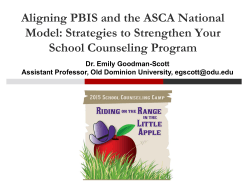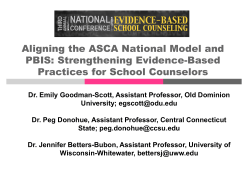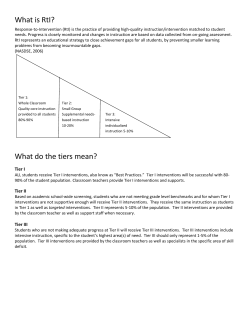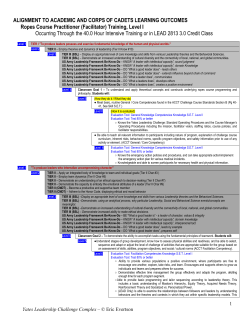
Vocabulary Instruction and the Common Core Illinois State Board of Education
Vocabulary Instruction and the Common Core Illinois State Board of Education English Language Arts Content Specialists Hosted by Kathi Rhodus, June, 2012 Content contained is licensed under a Creative Commons Attribution-ShareAlike 3.0 Unported License Today’s Targets Identify how the English Language Arts Common Core Standards address vocabulary Look at context clue instruction Become familiar with the concept of academic vocabulary (Tier 2 words) and why they are important to teach Explore strategies and resources for teaching vocabulary Content contained is licensed under a Creative Commons Attribution-ShareAlike 3.0 Unported License ELA Common Core Vocabulary Standards Reading Strand Reading Anchor Standard #4 Interpret words and phrases as they are used in a text, including determining technical, connotative, and figurative meanings, analyze how specific word choices shape meaning or tone. Language Strand Language Anchor Standard #4 Determine or clarify the meaning of unknown and multiple-meaning words and phrases by using context clues, analyzing meaningful word parts, and consulting general and specialized reference materials as appropriate. Language Anchor Standard #6 Acquire and use accurately a range of general academic and domain-specific words and phrases sufficient for reading, writing, speaking, and listening at the college and career readiness level; demonstrate independence in gathering vocabulary knowledge when encountering an unknown term important to comprehension or expression. Research Behind Vocabulary Instruction • Effective vocabulary instruction has to start early, in preschool, and continue throughout the school years (Nagy, 2005). • Teaching vocabulary helps develop phonological awareness (Nagy, 2005) and reading comprehension (Beck, Perfetti, & McKeown, 1982). • Vocabulary instruction needs to be long-term and comprehensive (Nagy, 2005) for ELLs (Carlo, August, & Snow, 2005; Calderón et al., 2005). More Research…. • Command of a large vocabulary frequently sets high-achieving students apart from less successful ones (Montgomery, 2000). • The average 6-year-old has a vocabulary of approximately 8000 words, and learns 3000-5000 more per year (Senechal & Cornell, 1993). • Vocabulary in kindergarten and first grade is a significant predictor of reading comprehension in the middle and secondary grades (Cunningham, 2005; Cunningham & Stanovich, 1997; Chall & Dale, 1995; Denton et al. 2011). Context Clue Steps For Students 1. Identify the unknown word. 2. Look for the words that give hints about its meaning in the sentence. 3. If you need more cues, read the sentences before and after the one with the word in it. 4. Infer the word’s meaning based on what you found. For Teachers Then model it… “As Tom stepped out of the tent, the moist grass soaked his shoes and he wondered if it had rained.” Say aloud… “The grass is moist. It soaks Tom’s shoes. Tom thinks it rained. Rain makes things wet. Moist must mean…..” “Now try ‘wet’ in place of moist to see if it makes sense.” Adapted from Vocabulary Instruction Module developed for Reading Excellence Act. Graves (2002) The SLAP Strategy ✔Say the word. ✔Look for clues. ✔Ask yourself what the word might mean; think of a word that expresses that meaning. ✔Put the word in the passage in place of the unfamiliar word. Does it make sense? Trying out the SLAP strategy He tried to open the box with no luck. He couldn’t find the key, so he decided to use a smidget. ✔ Say the word. ✔ Look for clues. ✔ Ask yourself what the meaning might be. ✔ Put word in the passage; does it make sense? Academic Vocabulary Isabel L. Beck, Margaret McKeown and Linda Kucan (2002, 2008) have outlined a useful model for conceptualizing categories of words readers encounter in texts and for understanding the instructional and learning challenges that words in each category present. They describe three levels, or tiers, of words in terms of the words’ commonality (more or less frequently occurring) and applicability (broader to narrower). Common Core State Standards, Appendix A, page 33 Academic Vocabulary … is not unique to a particular discipline and as a result are not the clear responsibility of a particular content area teacher. What is more, many Tier Two words are far less well defined by contextual clues in the texts in which they appear and are far less likely to be defined explicitly within a text than are Tier Three words. Yet Tier Two words are frequently encountered in complex written texts and are particularly powerful because of their wide applicability to many sorts of reading. Teachers thus need to be alert to the presence of Tier Two words and determine which ones need careful attention. Common Core State Standards (English Language Arts, Appendix A) 3 Tiers of Words – Highly specialized, subject-specific; low occurrences in texts; lacking generalization ◦ E.g., lava, aorta, legislature, circumference –Abstract, general academic (across content areas); encountered in written language; high utility across instructional areas ◦ E.g., vary, relative, innovation, accumulate, surface, layer – Basic, concrete, encountered in conversation/ oral vocabulary; words most student will know at a particular grade level ◦ E.g., clock, baby, Common Core State Standards, Appendix A, page 33 Why are “academic words” important? • They are critical to understanding academic texts. • They appear in all sorts of texts. • They require deliberate effort to learn, unlike Tier 1 words. • They are far more likely to appear in written texts than in speech. • They often represent subtle or precise ways to say otherwise relatively simple things. • They are seldom heavily scaffolded by authors or teachers, unlike Tier 3 words. Common Core State Standards, Appendix A, page 33 Choosing words • Jose avoided playing the ukulele. • Which word would you choose to preteach? Which word? Avoided Why? • Verbs are where the action is – – – – Teach avoid, avoided, avoids Likely to see it again in grade-level text Likely to see it on assessments We are going to start calling these useful words “Tier 2 words” • Why not ukulele? – Rarely seen in print – Rarely used in stories or conversation or content-area information How do I determine that a word is Word Is this a generally useful word? Does the word relate to other words and ideas that students know or have been learning? TIER 2? Is the word useful in helping students understand text? If you answer “yes” to all three questions, it is a Tier 2 word. If not, it is probably a Tier 3 word. In this presentation, we will look at a variety of strategies to teach academic vocabulary. Isabel Beck, Margaret Mckeown & Linda Kucan Robert Marzano & Debra Pickering Step by Step Vocabulary Instruction For Tier 2 words 1. Read the story/text. 2. Contextualize the word. 3. Have the children say the word. 4. Provide student friendly definition. 5. Give an example in another context. Steps continued…. 6. Engage children in interacting with words. a. Respond with actions. b. Answer questions/give reasons. c. Identify examples and non-examples. 7. Have students repeat the word again. 8. Review and use the new words. (Adapted from Bringing Words to Life by Isabel Beck, Margaret McKeown, Linda Kucan, 2000) Marzano’s Building Academic Vocabulary EIGHT RESEARCH-BASED CHARACTERISTICS OF EFFECTIVE VOCABULARY INSTRUCTION 1. Effective vocabulary instruction does not rely on definitions. 2. Students must represent their knowledge of words in linguistic and nonlinguistic ways. 3. Effective vocabulary instruction involves the gradual shaping of word meanings through multiple exposures. 4. Teaching word parts enhances students’ understanding of terms. 5. Different types of words require different types of instruction. 6. Students should discuss the terms they are learning. 7. Students should play with words. 8. Instruction should focus on terms that have a high probability of enhancing academic success. (Adapted from Building Academic Vocabulary by Robert Marzano and Debra Pickering, 2005) A Six-Step Process for Teaching New Terms Step 1: Provide a description, explanation, or example of the new term. Step 2: Ask students to restate the description, explanation, or example in their own words. Step 3: Ask students to construct a picture, symbol, or graphic representing the term or phrase. Adapted from Building Academic Vocabulary by Robert Marzano and Debra Pickering, 2005 A Six-Step Process for Teaching New Terms Step 4: Engage students periodically in activities that help them add to their knowledge of the terms in their notebooks. Step 5: Periodically ask students to discuss the terms with one another. Step 6: Involve students periodically in games that allow them to play with terms. Adapted from Building Academic Vocabulary by Robert Marzano and Debra Pickering, 2005 Students use a Graphic Organizer to Record The Information Adapted from Building Academic Vocabulary by Robert Marzano and Debra Pickering, 2005 How Many Words? • In school settings, students can be explicitly taught a deep understanding of about 300 words each year. • Divided by the range of content students need to know (e.g., math, science, history, literature), of these 300–350 words, roughly 60 words can be taught within one subject area each year. • It is reasonable to teach thoroughly about eight to ten words per week. (Chall, 1996) Implications for Instruction • Teach fewer words. • Focus on important Tier 2 (high utility, cross-domain words) to know & remember. • Simply provide Tier 3 (domainspecific, technical) words with a definition. Vocabulary Casserole Ingredients Needed: 20 words no one has ever heard before in his life 1 dictionary with very confusing definitions 1 matching test to be distributed by Friday 1 teacher who wants students to be quiet on Mondays copying words Put 20 words on chalkboard. Have students copy then look up in dictionary. Make students write all the definitions. For a little spice, require that students write words in sentences. Leave alone all week. Top with a boring test on Friday. Perishable. This casserole will be forgotten by Saturday afternoon. Serves: No one. Adapted from When Kids Can’t Read,What Teachers Can Do by Kylene Beers Vocabulary Treat Ingredients Needed: 5-10 great words that you really could use 1 thesaurus Markers and chart paper 1 game like Jeopardy or BINGO 1 teacher who thinks learning is supposed to be fun Mix 5 to 10 words into the classroom. Have students test each word for flavor. Toss with a thesaurus to find other words that mean the same. Write definitions on chart paper and let us draw pictures of words to remind us what they mean. Stir all week by a teacher who thinks learning is supposed to be fun. Top with a cool game on Fridays like jeopardy or BINGO to see who remembers the most. Serves: Many Adapted from When Kids Can’t Read,What Teachers Can Do by Kylene Beers Effective Vocabulary Instruction • Increase independent reading time. • Facilitate read-alouds. • Keep vocabulary in circulation. • Keep vocabulary interactive. • Use graphic organizers. Game Resources • • • • • • • Scattergories Taboo Crossword puzzles Boggle Upwords Balderdash Prop box Content contained is licensed under a Creative Commons Attribution-ShareAlike 3.0 Unported License Vocabulary Websites http://www.wordsift.com/ Word maps, word clouds http://quizlet.com/ Make flash cards & games http://jc-schools.net/tutorials/vocab/ Academic vocabulary games http://www.vocabulary.com/ More games, including games using Latin & Greek roots www.worldwidewords.com Definitions, history and short essays on words http://www.visualthesaurus.com/ Visual thesaurus www.vocabgrabber.com www.wordle.com Online resources for games… • • http://www.vocabulary.co.il/ http://www.freereading.net/index.php?title=Vocabulary_Reintroduce_and_ Build_Mastery_Activities • http://www.visuwords.com/ • • • • • http://www.pppst.com/templates.html http://jc-schools.net/tutorials/gameboard.htm http://its.leesummit.k12.mo.us/gameresources.htm http://people.uncw.edu/ertzbergerj/ppt_games.html http://reading.pppst.com/vocabulary.html 31 Recommended Resources • • • • • • • • • Beck, I.L., McKeown, M.G. & Kucan, L. (2002). Bringing Words to Life: Robust Vocabulary Instruction. New York: The Guilford Press. Baumann, J.F. 7 Kame’enui, E.J. (2004). Vocabulary Instruction: Research to Practice. New York: The Guilford Press. Graves, M.F. (2006). The Vocabulary Book: Learning and Instruction. New York: Teacher’s College Press. Diamond, L. & Gutlohn (2006). Vocabulary Handbook. Berkley, CA: Consortium on Reading Excellence, Inc. Hart, B., & Risley, T.R. (1995). Meaningful Differences in the Everyday Experience of Young American Children. Baltimore, MD: Paul H. Brookes. Heibert, E.H. & Kamil, M. (2005). Teaching and Learning Vocabulary: Bringing Scientific Research to Practice. Mahwah, NJ: Erlbaum. Marzano, R.J., & Pickering. D.J. (2005). Building Academic Vocabulary: Teacher’s Manual. Alexandria, VA: ASCD. Stahl, S.A. (1998). Vocabulary Development. Cambridge, MA: Brookline. Stahl, S.A. & Kapinus, B. (2001). Word Power: What Every Educator Needs to Know About Teaching Vocabulary. Washington, DC: NEA. References Beck, I.L., McKeown, M.G. & Kucan, L. (2002). Bringing Words to Life: Robust Vocabulary Instruction. New York: The Guilford Press. Chall, J.S. (1996). American reading achievement: Should we worry? Research in the Teaching of English, 30, 303-310. Graves, M.F., editor. Essential Readings on Vocabulary Instruction. International Reading Association 2009. Marzano, R.J., & Pickering, D.L. (2005) Building Academic Vocabulary: Teacher's Manual. Alexandria, VA: ASCD. "Common Core State Standards Initiative." National Governor's Association Center for Best Practices, Council of Chief State School Officers, 2010. Web. 12 Jun 2012. 33 Contact Information Sarah McCusker,100 N. First Street, Springfield, Illinois smccuske@isbe.net (217) 524-4832 Erik Iwersen, Area I-A,B,D eiwersen@s-cook.org (708) 544-4891 Amy Robinson, Area I-C arobinson@dupage.k12.il.us (630) 495-6080 Jill Brown, Area II jbrown@kidsroe.org (815) 636-3060 Katy Sykes, Area III and IV ksykes@i-kan.org (815) 937-2950 Kathi Rhodus, Area V and VI krhodus@stclair.k12.il.us (618) 825-3957 Content contained is licensed under a Creative Commons Attribution-ShareAlike 3.0 Unported License
© Copyright 2025





















